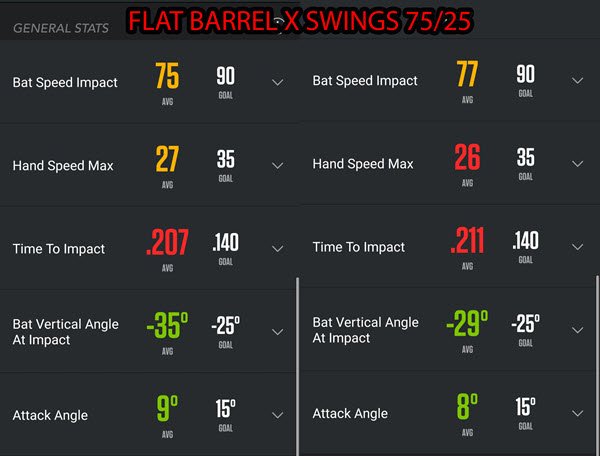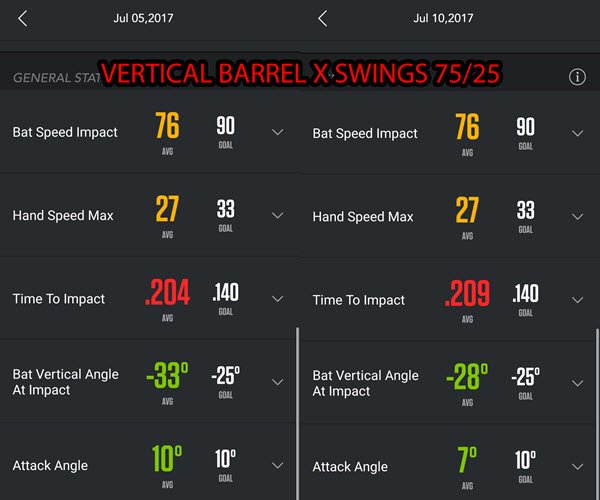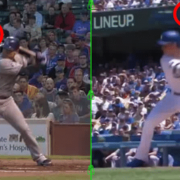Zepp Swing Experiment: Here’s a Quick Way to Fix a Flat Bat at Landing (and WHY!)
Discover fundamental how to coach quick hands, contact, and power hitting drills, techniques for beginners, and basic youth drills for baseball and softball players in the 8, 9, 10, 11, and 12 year old age range, in 2022. This Zepp swing experiment targeting a ‘flat’ bat at stride landing is VERY age appropriate for the ages previously mentioned.
Fundamental Baseball Question: How Does a Flat Bat at Landing Effect Bat Speed, Ball Exit Speed, & Time To Impact?
Using the Zepp (Labs) Baseball app and Pocket Radar Ball Coach, I wanted to employ the Scientific Method to analyze how a hitter’s “Flat Bat at Landing”, or toe touch, adds or takes away from key swing performance metrics including Bat Speed at Impact, Time To Impact, Attack Angle, and Ball Exit Speeds.
Let me define what I mean by ‘Flat Barrel’ versus a ‘Vertical Barrel’…
- A ‘Flat Barrel’ at landing is anything less than a 30-degree angle (like Cargo in the above video as an example),
- A ‘Vertical Barrel’ at landing is anything more than a 30-degree angle.
Now that we’ve defined the parameters, let’s look at the…
SCIENCE-BASED TRAINING:
Improve your hitting strategy dramatically by applying human movement principles.
Learn not only how and what to train but also the science behind the methods.
Background Research

Notice where the “dot” is drawn on the two static images left side, and where it’s drawn on the two dynamic images right side. Photo courtesy: GymSmartsCommunity.com
My background research is more experiential, rather than academic.
I have hitters do a mini-experiment by holding the bat in their bottom hand, laid flat (parallel to ground) over their back shoulder. And then ask them to hold the bat, using the same hand, but vertical. I then ask them which bat position is heavier/lighter? Of course they say the vertical bat is lighter. I then ask WHY? And I get a few different answers…
What is the fundamental baseball answer? Because we’re not adding or taking weight away from the bat by doing this…
It has to do with center of mass of the bat in relation to the hitter’s. A ‘Flat Bat at Landing’ pushes its center of mass behind the hitter’s. A human’s center of mass is generally around the belly button. To find the bat’s center of mass you can balance it between your thumb and forefinger.
I’ve also observed when adjusting a hitter’s ‘Flat Bat at Landing’ to a more ‘Vertical Bat at Landing’, there’s a bump in Ball Exit Speed, which I measure at the beginning (before instruction is given) and end of a hitting lesson. My hitter’s also share they feel quicker to impact, have a little more ‘pop’, and that it’s easier getting the ball in the air.
It’s also interesting to note that I see quite a bit of early barring of the front arm when the hitter lands with a flat barrel. I also see the hitter “wrapping the bat” around their head. In my opinion this is a compensation to manipulate the shifted center mass of the bat from behind the hitter.
CLICK HERE to watch this fundamental baseball video on how to fix a ‘Flat Bat at Impact’.
Hypothesis

Look at the difference in bat angle at landing between Carlos Gonzalez (left) – “Flat” and Cody Bellinger (right) – “Vertical”. Just because a Big Leaguer does it doesn’t mean it’s effective or optimized. Oftentimes they succeed despite ineffective mechanics. Photos courtesy: MLB.com
In support of the Background Research above, I’m hallucinating that we’ll see a bump in Bat and Ball Exit Speeds, in addition to a reduction in Time To Impact. I also think that we’ll see a more positive move in the barrel’s Attack Angle.
Flat Versus Vertical Bat at Landing Experiment
Equipment Used:
- Zepp Baseball app (to measure Bat Speed, Hand Speed, Time to Impact, & Attack Angle),
- Pocket Radar Ball Coach
to measure Ball Exit Speeds,
- Backspin batting tee,
- Two yellow dimple baseballs (feedback markers),
- Flip camera
to record swings, and
- 33 inch bamboo bat.
Fundamental Baseball Experiment Setup:
- Yellow dimple ball feedback markers to keep starting footwork the same = bat length…I used two yellow dimple ball markers to make my stance setup consistent. One was placed inside my back foot, close to the plate. The other was placed one bat’s length ahead of the back marker.
- Backspin tee was set one baseball’s length behind the front feedback marker, and tee height was about mid-thigh
- We stayed as consistent as we could with keeping the ball height and depth the same for most swings.
- I broke each swing down into a couple steps: 1) Get to landing, 2) Pause for 2-secs, and 3) Swing. The reason for this was to control the bat either flat or vertical at landing.
- The two tests in the swing experiment were counter-balanced. Which consisted of eight blocks of 25-swings done in the following order ABBA BAAB. ‘Flat Bat at Landing’ was letter ‘A’, and ‘Vertical Bat at Landing’ was letter ‘B’. 200 total swings were completed in the experiment, 100 per test. Counter-balancing helps remove the “getting tired” and “warm up” factors.
- The objective of ‘Front Facing Swings’ was to start the ‘belt buckle’ pointing at the pitcher, and to minimize pelvic movement.
- Fundamental baseball Experiment Day-1 on 7/5 we completed 150 total swings (75 ‘Flat Barrel at Landing’ & 75 ‘Vertical Barrel at Landing’). Experiment Day-2 on 7/10 we completed 50 swings (25 ‘Flat Bat at Landing’ & 25 ‘Vertical Bat at Landing’).
- We had to break the 200 total swings into two days, with the second day coming 1 week later, because of time constraints.
Data Collected (Zepp Baseball App & Ball Exit Speed Readings):
‘Flat Bat Swings’ Days 1 & 2 side by side…

Flat Barrel at Landing swing averages of the averages: 76-MPH Bat Speed at Impact, 26.5-MPH Hand Speed Max, .209 Time To Impact, -32* Bat Vertical Angle at Impact, & 8.5* Attack Angle.
‘Vertical Barrel Swings’ Days 1 & 2 side by side…

Vertical Barrel at Landing swing averages of the averages: 76-MPH Bat Speed at Impact, 27-MPH Hand Speed Max, .206 Time To Impact, 30.5* Bat Vertical Angle at Impact, & 8.5* Attack Angle.
CLICK HERE for the Ball Exit Speed Google document. The findings?
- Flat Barrel at Landing AVERAGE Ball Exit Speed = 79.01-MPH
- Vertical Barrel at Landing AVERAGE Ball Exit Speed = 81.08-MPH
- Difference = 2.01-MPH Ball Exit Speed bump with more Vertical Barrel at Landing
Data Analysis & Fundamental Baseball Conclusion
Zepp data analysis comparing the averages of averages:
- We saw NO change to Bat Speed at Impact between the two swings,
- We saw a 0.5-MPH boost to Hand Speed Max when holding a ‘Vertical Bat at Landing’,
- We saw a .003 second reduction in Time To Impact when holding a ‘Vertical Bat at Landing’,
- We saw a +1.5-degree increase to Bat Vertical Angle at Impact when holding a ‘Vertical Bat at Landing’,
- We saw NO change to the Attack Angle between the two swings, and
- We saw a 2.01-MPH increase in Ball Exit Speed when holding a ‘Vertical Bat at Landing’.
Based on the above Data Analysis it looks like my Hypothesis was proved right when it came to a boost in Hand Speed Max and Ball Exit Speed, and decrease in Time To Impact, but wrong when it came to Bat Speed at Impact and Attack Angle. I think the increase in Ball Exit Speed can be attributed to the decrease in Time To Impact.
When we see ineffective movement at the Big League level, we have to understand that these high level hitters are succeeding despite ineffective movements, not because of them.


